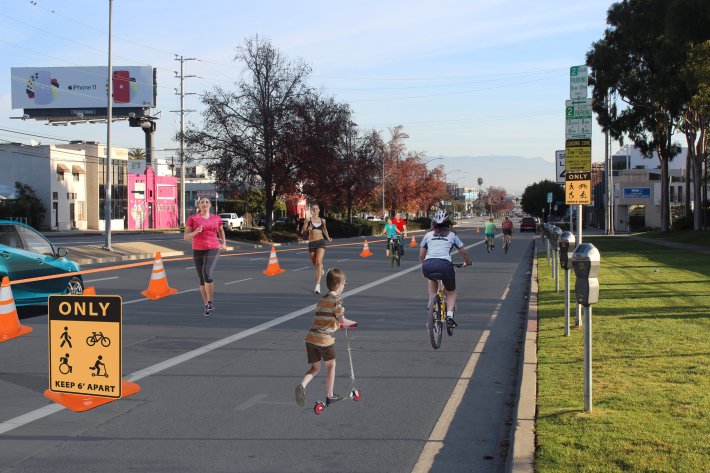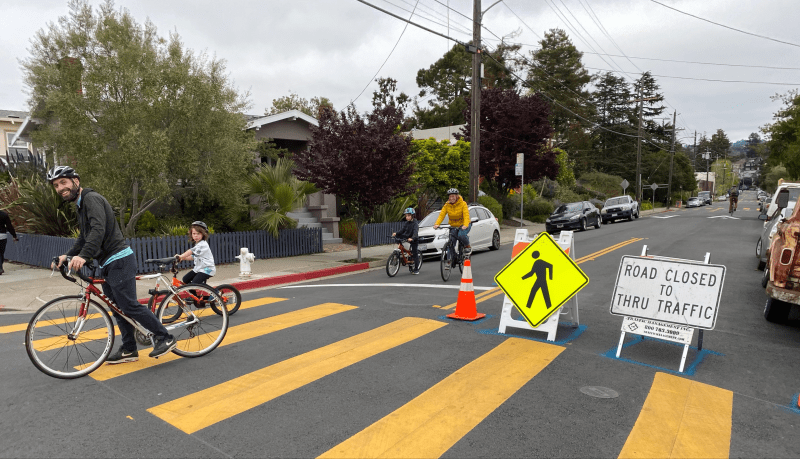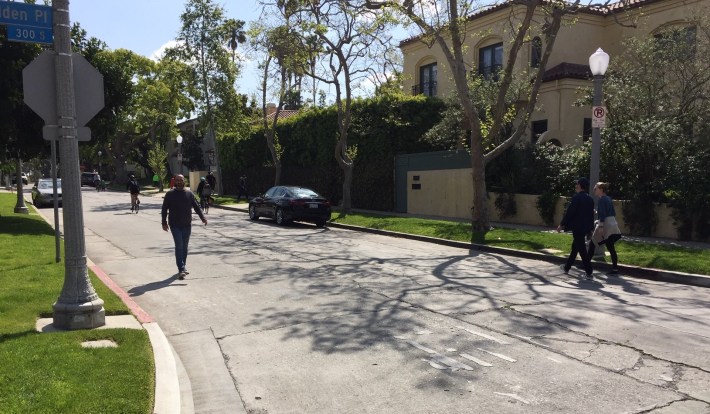
Under COVID-19 stay-at-home orders, Angelenos are staying home. Driving is way down. To get exercise while physically distancing, lots of people are doing plenty of walking and bicycling. Unfortunately speeding is up, and L.A. still suffers from dangerously overbuilt streets, with meager accommodations for people on foot and bike - often insufficient for needed distancing.
In many parts of the world, cities are responding to the COVID-19 crisis by implementing quick-build measures to make streets better serve the present need for safe walking and bicycling.
Berlin’s temporary protected bike lanes installed almost overnight in response to #COVID19. 🚲 pic.twitter.com/Yy1AFllE8C
— Jonathan Berk (@berkie1) April 23, 2020
There are lots of examples - from San Francisco to Portland to Minneapolis to Philadelphia to Calgary. Some are more successful than otherrs. Find listings at both the National Association of Transportation Officials (NACTO) recommendations and Dr. Tabitha Combs’ document tracking examples.
Programs in Oakland and Seattle could inform similar improvements in Southern California. Oakland has planned 74 miles of calmed streets, eight sections of which are implemented so far. Oakland has taken a very simple and inexpensive approach, using basic sandwich board barricades to close already quiet, mostly residential streets to cut-through traffic. Seattle's program is similarly quick-build, with criteria that expressly improves "areas with limited open space options, low car ownership and routes connecting people to essential services and food take out."
For more than a month, there have been discussions of Southern California cities following suit, though so far no quick-build safe streets have resulted.
The Beverly Hills City Council considered a proposal to close some lanes to cars and open them for walking and bicycling, though it was not approved.
In early April, L.A. City's Del Rey Neighborhood Council passed a resolution calling on L.A. City Transportation Department (LADOT) and Mayor Eric Garcetti to quickly enhance "mobility and open space access in Los Angeles during COVID-19... [via a] temporary emergency safe streets network... redistributing street space to widen sidewalks and create temporary protected bike lanes using cones or other temporary infrastructure" as well as "implementation of LADOT’s Play Streets” in the Del Mar area. Their City Councilmember Mike Bonin took up the call. He urged LADOT General Manager Seleta Reynolds to take a “family-friendly” approach to "open more space on city streets for residents to walk, bike, run and play during the COVID-19 crisis." Bonin specifically noted COVID-19 isolation difficulties are "particularly acute for renters and people living in multi-family buildings without a yard."
The organization Streets for All has been advocating for L.A. to open streets in response to the COVID-19 crisis. This week, Streets for All joined with twenty other entities in posting a letter urging L.A. leaders to create "an emergency people street network - using cones or other temporary infrastructure - to create additional sidewalk and open space for people to walk, run, scoot, and bike in, while maintaining 6’ of distancing." Signees range from bike and walk nonprofits to for-profit mobility companies.

Streetsblog inquired about the city's response to the growing call for quick-build safe streets. LADOT spokesperson Colin Sweeney responded that, "First and foremost, we have focused on harm reduction: making transit free, freezing parking fine increases, suspending almost all parking enforcement, and mobilizing transit service to move unsheltered Angelenos to hotels and temporary shelters. This includes expediting street projects with community buy-in, eliminating pushbuttons at almost 20% of intersections, and making citywide changes to signals to slow down drivers. In response to his request, we are working with Councilmember Bonin to identify streets and treatments and implement changes in his district, led by the Neighborhood Council. Any further expansion must respect community needs and public health guidance."
Mayor Garcetti's Deputy Press Secretary's Harrison Wollman responded that "The Mayor's office is thankful for Councilmember Bonin's leadership, and has directed LADOT to work with him to identify projects in his district. We are considering how to implement a city-wide safe streets program that's consistent with guidelines from our public health experts."
Streets for All and others are continuing to push for implementation (to join their effort, sign up at their webpage), but city staff clearly are not fast-tracking any kind of response. Not even in Bonin's district. Not even at a time when Angelenos are already walking in greater numbers, and more than ever space is needed to keep them safe.








